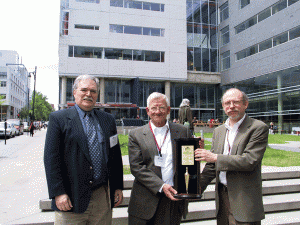General Tools Award 2003 – Alex Barbour
2003 General Tools Award Winner – Alex Barbour (center) with Robert Passfield (left) & Gerald Weinstein (right)
Photograph by Perry Green
Bob Passfield made the following presentation of the 2003 General Tools award at the SIA 2003 Annual Meeting:
“The Society for Industrial Archeology General Tools Award for Distinguished Service to Industrial Archeology recognizes individuals who have given sustained, distinguished service to the cause of industrial archeology. Nominations for the award may be made by any SIA member in good standing. The criteria for selection are as follows: the recipient must have given noteworthy service, over an extended period of time, to the cause of industrial archeology. The type of service is unspecified, but must be for other than academic publication. It is desirable, but not required, that the recipient be a member of the SIA. And finally, the award may be made only to a living individual.
“The General Tools Award was established in 1992 by Gerry Weinstein, Chairman of the General Tools Manufacturing Company, and is funded through an endowment created by the Abraham and Lillian Rosenberg Foundation. Before proceeding with the award, I would like to express my appreciation to the other members of the General Tools Award Committee, Betsy Fahlman and Pat Malone, for their substantial contributions to the evaluation process.
“This year’s recipient of the Society for Industrial Archeology’s General Tools Award has been involved with machinery and engineering all his life and is a hands-on practitioner of industrial archeology with a prodigious knowledge of machinery of all types. A millwright and mechanical engineer by profession, he has achieved a wide recognition for his expertise in machinery restoration, millwrighting, and marine engineering.
“Alex Barbour, an IA consultant, and former Chief Engineer (retired), of the Marine and Industrial Conservation unit of Canada’s Public Works Department, has had a widely varied career marked by impressive achievements. Alex was born in Dundee, Scotland, an area rich in industrial heritage, and began his working career in 1953 as an apprentice millwright in a local flax mill, Baxter Brothers. After completing his apprenticeship as a millwright and graduating in Marine Engineering from Dundee Technical College (now University of Albertay), Alex went to sea on the ships of Ben Line Steamers Ltd. of Edinburgh and earned his First Class Steam Certificate.
“In 1964 he emigrated to Canada with his young family and entered upon a teaching career. Alex taught marine engineering at George Brown College in Toronto and subsequently became Head of the Marine Engineering Department. In 1973, Alex joined Parks Canada (now a federal government agency) where he specialized in the preservation and restoration of historic ships and industrial machinery and rose to the position of Senior Engineer, Machines and Vessels. When the heritage conservation program was transferred to the Department of Public Works in 1986, Alex followed and served as Chief Engineer of the Marine and Industrial Conservation unit. On his retirement in 1996, Alex established a private consulting practice and continues to be heavily involved in machinery and marine restoration projects both in Canada and abroad.
“Over twenty-three years of service with Parks Canada and Public Works, Alex was responsible for the stabilization, conservation, and restoration of a large number of historic ships, several grist mills and industrial plants, and numerous steam engines, as well as historic machinery of many kinds. Among his major contributions to the field of industrial archeology were the stabilization and restoration of several large vessels now being preserved and interpreted as national historic sites. These include the S.S. Moyie (Kaslo, B.C.), S.S. Klondike (Whitehorse, Yukon), and S.S. Keno (Dawson, Yukon) sternwheel steamers; the St. Roch (Vancouver, B.C.), the first ship to traverse the Northwest Passage from west to east, and the HD-4 Hydrofoil of Alexander Graham Bell (Beddeck, Nova Scotia).
“Other major achievements include the restoration of two compound steam walking-beam engines at the Hamilton Water Works National Historic Site (Hamilton, Ontario); the stabilization, decontamination, and restoration of a herring reduction plant at the Gulf of Georgia National Historic Site (Stevenson, B.C.); and the salvaging of a 2000-ton gold dredge trapped in the permafrost of the Yukon, and its stabilization and restoration for subsequent interpretation as Dredge No. 4 National Historic Site (Bonanza Creek, Yukon). In all of these major heritage industrial preservation projects, Alex played a critical and highly unusual dual role. As a registered professional engineer he planned the projects and supervised the project teams; and as a millwright, he employed his practical knowledge and trade skills in carrying out the work required. He got his hands dirty, and enjoyed it.
“In addition to his field work, Alex Barbour has made a significant contribution to IA through sharing his knowledge and experience with others. Over the years, he has been an enthusiastic participant in SIA Conferences and was an organizer and highly-knowledgeable tour guide for the Yukon Study Tour in 1990. He has been active in several heritage preservation societies; and has made presentations on his projects and heritage and preservation practices and techniques at conferences of the SIA, the Association for Preservation Technology (APT), the Canadian Institute of Marine Engineers (CIMarE), and at sessions of the International Conference on the Preservation of Large Historic Vessels.
“Widely recognized for his expertise in historic ship and machinery restoration work, Alex has served as a consultant for the Canadian federal government, provincial governments and heritage agencies across Canada, and has worked on IA projects as far as the Falklands, Martinique, and the U.S. Virgin Islands. In recognition of his outstanding contributions to industrial preservation, he received the Freeman Award (1992) from Public Works, and the Award of Excellence (1993) from Parks Canada.
“A gregarious person who loves ships and technical challenges, Alex has few peers in the combination of skills and specialized knowledge that he brings to the preservation of historic ships and industrial machinery, and in the nature of the outstanding contributions he has made to the IA field during a lifetime commitment to industrial heritage preservation work. Alex Barbour is truly a worthy recipient of the General Tools Award for 2003.
Mr Barbour proceeded to the podium where he told the assembled society “You have honored me, I have always envied this. This is the third plumb bob I have owned. The first is still learning how to swim in the River Thames, the second is in my tool box…” He proceeded to explain that a plumb bob can generate eight tools, and how it figured decisively in deciphering the derivation of the “megalithic yard,” a unit of measurement common to henges and other ancient works in the British Isles and Europe. “This [unit of about 32.25 inches] would have made a great alternative to the meter!” He quipped that the plumb bob is a source of fear and enjoyment, and that as an engineer, it has even been a source of humor.


